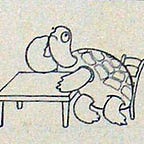131. Today in 1920s Turkey: 2 January 1922 (Good Luck Charm)
Comments
This cartoon features a caricature of a famous local Istanbulite, Pazarola Hasan Bey. He was described as a madman (deli) but exactly what psychological or physiological condition applied to him is unknown. He was well known among shop keepers of Istanbul’s Fatih district and made sporadic appearances in cartoons of the early 1920s. Many of the Istanbul-based cartoonists looked to their immediate surroundings for inspiration which explains why persons like Pazarola Hasan Bey and other “characters” enjoyed the occasional cameo in their works. Short in stature but very friendly, Hasan Bey got his name from the greeting he uttered to those he came in contact with, “Pazar ola” which was a wish for “good trade!” According to his Turkish Wikipedia (Vikipedi) page Pazarola Hasan Bey’s greeting was sought after and it was believed to bring prosperity to a business and even help barren woman become pregnant (?!).
In the case of the present cartoon, a diminutive Pazarola Hasan is shown alongside a visibly amorous couple. Below are the words “Good trade, head flirter!” (or Pazarola… fındıkçı başı!) spoken by Pazarola Hasan Bey. Fındıkçı is a term used for flirtatious women and in directing his “well wishes” to the fındıkçı woman he is identifying her as a tradesperson and the man as her patron. Indeed, the man is dressed in fine, fashionable clothes-certainly representing a “bountiful” catch for an enthusiastic woman. This cartoon playfully floats one more example of the range of this man’s powers, in essence adding to the mythos surrounding the force wielded by his words.
Incidentally, this is the first issue of the short-lived satirical journal (Jan-Nov 1922) published in Istanbul. This inaugural issue included one cartoon on each of its four pages. Today’s cartoon is one of two that appeared in the present issue by the artist Ahmet Rıfkı (p. 2 and p. 4). Other cartoonists whose work appeared in the first issue of Aydede are Cemil Cem (p. 1) and Ahmet Münif (p. 3). Aydede can refer to a full moon or literally “Grandfather” (dede) “Moon” (ay). In accordance with this appellation, the journal’s masthead includes the depiction of a mustached man’s face within a crescent moon which is shining over the skyline of Istanbul’s historical peninsula. Superimposed upon the calm, nocturnal landscape is the name Aydede (آی دده) and the artist, Rıfkı’s signature is located in the lower left corner of the composition.
More information about Rıfkı, the artist of today’s cartoon and Aydede’s first masthead, can be found in: Çeviker, Turgut. “Ahmet Rıfkı Üzerine.” In: Karikatür Üzerine Yazılar, 64–70. İstanbul: İris Yayınları, 1997.
Originally published at https://steemit.com on January 3, 2018.
